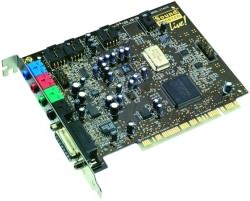| Four Point Surround 2000
by Tim "Flyboy" Henderson with Leonard "Viking1" Hjalmarson |
||||
|
Cables and Power The power unit for this system is the largest I have ever seen, although the unit for Microsoft's force wheel was close. Thankfully, there is a cord on one end and a cord on the other, so you won't have to park this monster on your power bar. The cables for the satellites are 3m long for the front, and 5m for the rear. I attached the small labels as I went along so that I would be sure to get my connections right. The 1/8" mini jacks are color coded, but you won't need them anyways if you are using the SB Live DIN connection. Digital or Analog? I have some friends who still use... turntables! And some of the people (over forty so their brains are going numb) even have tubes in their amplifiers! Ok, I know it sounds weird, like watching Spock construct an interpreter for his tricorder in that 1969 edition of the original Star Trek series. But most of these units do produce good sound. There is good sound, and then there is GOOD sound. The whole idea of digital is to keep things clean, and if you have to convert analog to digital or digital to analog, you are going to lose something in the process. Those of you who speak more than one language will know what I mean. In spite of that it's all theory, and the question is: what is the difference in practice using the SB Live analog output vs. digital output? For analog testing we hooked up the color coded cables supplied to my Montego II Quadzilla and for digital testing we substituted the SB Live!. Sound quality was impressive throughout the spectrum, with crips highs and a strong midrange. Simply put, most people will be surprised by the quality for this price point. Testing in games alone, we could't hear any difference between pure digital and analog output unless we had the sound at excessive levels where some hiss would appear in analog mode. When we popped in the jazz that Len brought with him we noticed the same at high levels, but not much difference otherwise. |
 But when playing some soft pop stuff with crystal clear vocals.. (yes, two famous Canadians, Loreena McKennitt and Sarah McLachlan, the former being an acquaintance of my wife from her high school days), it became evident that there really IS something to a digital throughput. Here at COMBATSIM.COM™, we have seen the light! Quality and Limitations The crystal voices of McKennitt and McLachlan (hmm, must be something in the water in Scotland) the twang of the strings on the acoustic guitars, hearing the musician's fingers slide up the fret, hearing the beginning of the breath creating the note on the flute... all these things come alive with a quality sound system. I found that sound was being created in the space between the satellites, exactly as it should appear, rather than seemingly sourced from the speakers themselves. Nevertheless, the system isn't quite perfect. Remember, I am a music buff and am used to getting some serious performance from my equipment. Remember also that we are talking about a speaker system that can be had for $139 US versus my $2000 home theatre system! As we cranked the sound to ear blasting levels we began to notice that the sub was distorting. The maximum sound output from this unit is 105 decibels, enough to penetrate a few levels of flooring. As we continued to push the system, there was also minimal distortion heard from the satellites, but still no hiss. In fairness, the full power rating does mention 10% THD and most people are not going to push the system this hard, especially in an office. Go to Page Four: Summary
|
|||
|
Copyright © 1997 - 2000 COMBATSIM.COM, INC. All Rights Reserved. Last Updated July 5th, 1999 |
||||
